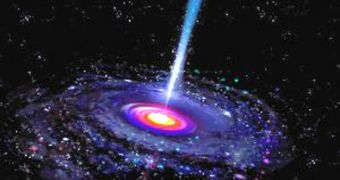Experts at the University of Colorado in Boulder (UCB) propose a new model for how the earliest black holes formed. They say that their research has led them to believe that what are now the behemoths of the skies, keeping entire galaxies in their place, originally developed inside dense, star-like cocoons, which prevented the gases around the infant structures from dissipating and favored their formation. The powerful X-ray radiations that black holes are familiar for may have also been quenched by the same formation process, which may have involved two stages.
Professor Mitchell Begelman – the chair of the UCB Astrophysical and Planetary Sciences Department and the leader of the new study – argues that supermassive stars, which are generally considered to be the precursors of black holes, started forming in the early Universe within a few hundred million years after the Big Bang. This is far earlier than the end of the Reionization Epoch, which is believed to have concluded about 1 billion years after our Universe exploded into being. Details of the idea are to be published in an upcoming issue of the journal Monthly Notices of the Royal Astronomical Society.
The expert also says that such a star would have grown inside the protective cocoon to unfathomable sizes, of tens of millions of times the mass of the Sun. However, this size would have come with a disadvantage, and namely a life span of just a few million years. The celestial body would have rapidly exhausted its hydrogen fuel and would have been left unable to support nuclear fusion. In the new study, Begelman and his team basically calculated the possible mass and evolution of these stars and inferred that they may have left behind “seed” black holes after their death.
“What's new here is we think we have found a new mechanism to form these giant supermassive stars, which gives us a new way of understanding how big black holes may have formed relatively fast,” the team leader says. The second part of the process, which may have begun once the “seed” black holes were in place, has been dubbed the “quasistar” stage. In this scenario, the bloated envelope of gas surrounding the structures would have provided them with a plentiful source of “food” and the black holes gobbled it up accordingly.
Over time, the quasistar cooled to a point where it began shedding massive amounts of characteristic radiation, which would have dispersed the protective cocoon, leaving behind a familiar-looking black hole, roughly 10,000 times the mass of our Sun, perhaps even more. “Until recently, the thinking by many has been that supermassive black holes got their start from the merging of numerous, small black holes in the universe. This new model of black hole development indicates a possible alternate route to their formation,” Begelman concludes.

 14 DAY TRIAL //
14 DAY TRIAL //